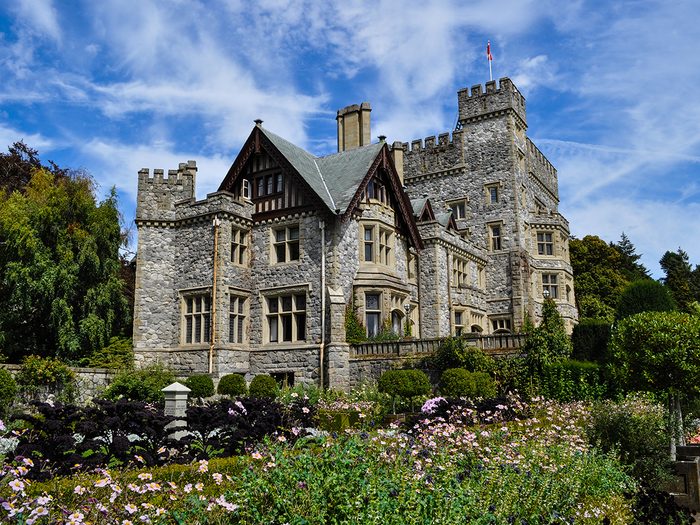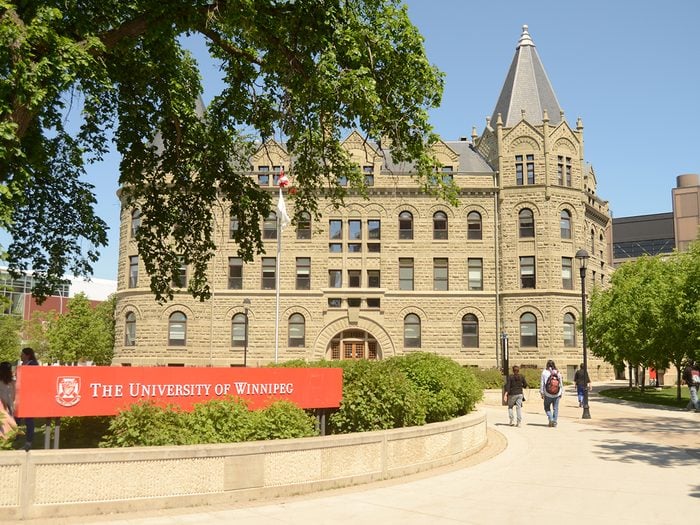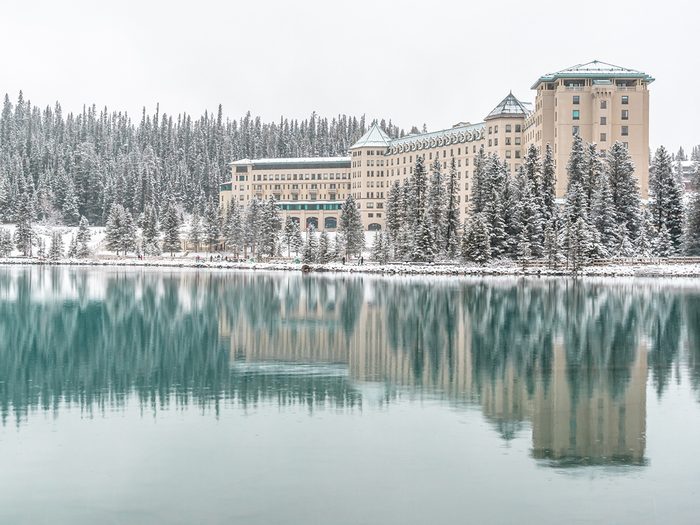
Yes, There Are Castles in Canada!
Though they might look like imposing fortresses, the castles in Canada were built for wealth, not war. Erected in the 19th and early 20th centuries, these castles often served as homes for the elite or fancy getaways for travellers riding the country’s then-expanding cross-country rail network. Today, you can still find these landmarks looming over bustling cities and at the heart of enchanting forests, where they stand as magical monuments to our country’s rich and unique history. Here are 10 castles in Canada worth adding to your bucket list.

Stone Hall Castle, Regina
On the outside, Regina’s Stone Hall Castle could almost pass as an ordinary house. But behind its nearly 100-year-old limestone walls lies an other-worldly medieval European experience.
In 1926, Francis Nicholson Darke built the castle as a safe haven for his wife, Annie, who was terrified of cyclones. He commissioned the finest masons, carpenters and artisans of the time to build a fortress capable of withstanding even the mightiest Prairie storm. Everything is made of stone, from the walls to the roof, and the castle even has a bomb shelter in the basement. (Take a look back at the worst natural disasters in Canadian history.)
In recent years, Stone Hall Castle’s interior has undergone a medieval-inspired renovation to complement its fascinating history and is decked out with furniture, tapestries and original Old Masters oil paintings from the 16th, 17th and 18th centuries. Guided tours of the castle are available seven days a week.

Hatley Castle, Colwood, British Columbia
Imagine for a moment that you and your partner are building a house and you’re having a dispute: you want your house to be the setting for fancy dinner parties, but your partner wants a place with ample space for fishing and shooting. How do you reconcile these two concepts? Well, if you’re a fabulously rich Canadian industrialist and politician and it’s the year 1908, you commission a renowned architect to build Hatley Castle—named in the tradition of British and European private estates.
James and Laura Dunsmuir’s Scottish baronial-style mansion boasts 82-foot-high turrets and 42 rooms featuring oak and rosewood panelling, teak floors, a baronial fireplace and custom light fixtures. The surrounding estate also includes gardens, old growth forests, lagoons and nature trails where hunts historically took place.
You’ll find this unusual yet unquestionably beautiful property in Colwood, just west of Victoria on Vancouver Island. You can visit the gardens for free, but if you want to explore behind the castle walls you’ll have to book a guided tour (offered seasonally from April to September).
Discover 25 more incredible things to do on Vancouver Island.

Château Laurier, Ottawa
The Fairmont Château Laurier is often referred to as Canada’s “Third Parliament”—and for good reason. Over the years, leadership conventions have been held in the hotel’s ballroom and back room deals have been worked out in the hotel’s restaurants. Pierre Trudeau (aka Justin’s dad and Canada’s 15th PM) was known to swim in the hotel pool every day. It even looks the part: built from 1908 to 1912, the Château was designed in French gothic style to complement the nearby Parliament buildings. You don’t have to be a politician to enjoy this stunning castle, of course: Anyone can book a stay in one of the hotel’s 426 guest rooms, some of which overlook the Rideau Canal and the Ottawa River.
You’ll want to add these great day trips from Ottawa to your itinerary.

Wesley Hall, Winnipeg
Wesley Hall is Winnipeg’s oldest educational facility and it certainly looks the part. Completed in 1895, the castle-like structure housed the classrooms, offices and dormitories of Wesley College, a theological institute associated with the Methodist Church and University of Manitoba. The historic building is now part of the University of Winnipeg campus and serves as the school’s convocation hall. The fact that Wesley Hall is flanked on either side by modern buildings makes its bold features—like its broad entrance arch, textured stonework and prominent tower—stand out even more. You can visit the Richardson Romanesque-style hall on a Winnipeg Architecture Foundation tour.
Find out 50 reasons you’ve got Winnipeg all wrong.

Chateau Lake Louise, Lake Louise, Alberta
Visiting Fairmont Chateau Lake Louise is like stepping into wonderland. Located in Alberta’s Banff National Park, the castle is hugged by lush forests and soaring mountains and sits on the edge of a glistening turquoise glacial lake that freezes in the winter (so you can walk or skate on the ice). All this makes it perfect for outdoor adventure seekers, offering easy access to hiking trails and ski hills.
Chateau Lake Louise has undergone a lot of changes over the years: originally a log cabin hotel built by the Canadian Pacific Railway, it was rebuilt in 1890 after a devastating fire and then underwent a massive expansion in 1920. Today, visitors can stay in one of 539 rooms or suites and soak up unbelievable views of Canada’s famous lake as well as Victoria glacier and Fairview peak.
Explore more of Canada’s greatest hotels.

Craigdarroch Castle, Victoria
Built as the home of the richest man in 19th century British Columbia, Craigdarroch Castle contains the type of oddities you might expect from an eccentric coal baron: a boxed-frame wreath made of human hair, an early 18th century Kindle-like contraption that allows for hands-free reading, as well as 39 rooms, 17 fireplaces, and four floors packed with stained glass windows and expensive Victorian-era furnishings.
Planning a visit to this Scottish baronial-style mansion-turned-museum? Be warned: the castle’s owner, Robert Dunsmuir, died 17 months before construction finished and visitors have claimed to hear whispers and piano music echoing down empty hallways.
Check out Canada’s most haunted places—if you dare.

Banff Springs Hotel, Banff, Alberta
The Fairmont Banff Springs Hotel that visitors see today isn’t the same one originally built by the Canadian Pacific Railway in 1888: that one was a wooden structure and burned down 1926 during hotel renovations and additions. The expanded version of the hotel, influenced largely by Scottish baronial architecture, was completed and reopened in 1928.
Nicknamed the “Castle in the Rockies,” the hotel has a whopping 757 guest rooms, stands at an altitude of 1,414 metres and has a footprint of 720,000 square metres. Located in front of Mount Rundle, the imposing structure provides guests with unbeatable views of the Canadian Rockies and unforgettable outdoor activities, like snowshoeing and tours of ice canyons.
Here’s more Alberta scenery that’ll have you packing your bags.

Casa Loma, Toronto
In 1911, Sir Henry Pellatt encouraged his team of architects to indulge their imaginations when designing his future digs in Toronto. They indulged all right, designing a flamboyant Gothic Revival style castle with 98 rooms, 30 bathrooms, an electric elevator, a dining room that seats 100, three bowling alleys, a rifle range, soaring towers, winding secret passageways, an 800-foot tunnel for horses and five acres of gardens. To keep the grand house—known as Casa Loma—running, Pellatt had to employ 50 full-time cooks, cleaners and gardeners.
Unfortunately, this architectural dream turned out to be a nightmare for Pellatt, who was driven to near-bankruptcy during World War I. As a result of Pellatt’s financial losses, Casa Loma fell into disrepair, racked up more than $27,000 in back taxes, and was finally seized by Toronto City Council in 1933.
Casa Loma is now a major Canadian tourist attraction operated by the city of Toronto. You can visit daily from 9:30 a.m. to 5 p.m.
Discover the most famous house in every province.

Digby Pines, Digby, Nova Scotia
Digby Pines, which first opened in 1905, originally served as quarters for army officers during World War I, offering electricity, hot water and all the comforts and conveniences of turn-of-the-century Nova Scotia. After the war, the Canadian Pacific Railway bought Digby Pines and completely rebuilt it in Norman Chateau style to suit the tastes of railway and steamer passengers in 1929.
A hotel to this day, guests can enjoy the 18-hole golf course constructed under the direction of renowned Canadian golf course architect Stanley Thompson in 1931, a large landscaped outdoor heated pool and extensive grounds that offer unbeatable views of the beautiful Annapolis Basin and the Digby Gut, a channel that connects to the Bay of Fundy.
Check out 13 great Canadian golf courses you can play for under $100.

Dundurn Castle, Hamilton
Gas lighting? Check. Running water? Dundurn Castle’s got that too. These amenities represented the very height of luxury living in Canada in 1835. Hamilton’s castle, built by Sir Allan Napier McNab for the princely sum of $175,000 (roughly $5.4 million today), was constructed using the most advanced techniques of the early 19th century and was considered one of Ontario’s most palatial residences at the time.
Castle tours let you explore every nook and cranny of the premises. The knowledgeable guides are also dressed in period costumes, helping visitors appreciate what it was like to live like the Canadian elite in the 1850s.
If these castles in Canada have sparkled your wanderlust, you’ll also want to check out Canada’s tallest buildings.